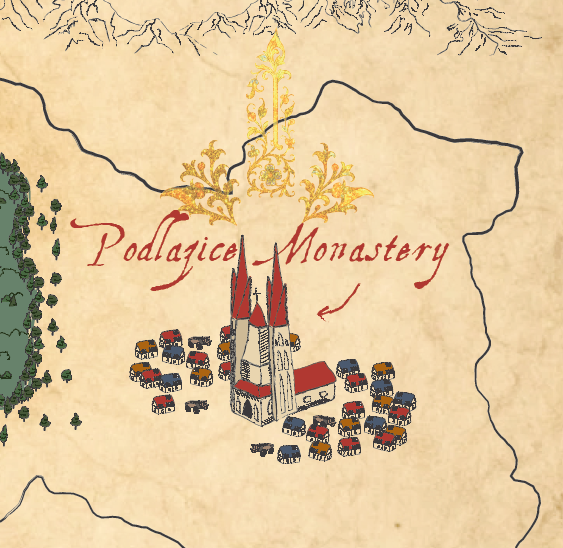First stop
Podlazice Monastery
Podlazice was a tiny Benedictine monastery in eastern Bohemia, near today’s town of Chrast. Despite its small size and poverty, it was here that the enormous Codex Gigas was written around 1229.
According to legend, a monk broke his vows and was sentenced to be walled up alive. To escape this punishment, he promised to create in one night a book that would glorify the monastery forever. Realizing he couldn’t finish alone, he is said to have made a pact with the Devil, who then appears in the manuscript’s most famous illustration. Historically, the manuscript would have taken years to complete, probably by a single scribe, and its size and lavishness were remarkable for such a poor monastery.
The monastery’s poverty meant it couldn’t safeguard such a treasure. Later, Podlažice was destroyed during the Hussite Wars in the early 15th century, leaving the Codex as its most enduring legacy.
second stop
sedlec Monastery
After Podlazice’s destruction, the Codex was transferred to Sedlec Abbey, a wealthy Benedictine foundation near Kutná Hora. Sedlec grew enormously rich thanks to the discovery of silver mines in the region.
While at Sedlec, the Codex Gigas gained protection in a more stable and prestigious setting. The abbey was a major cultural and religious center in Bohemia. At this time, the manuscript may have been used as both a library treasure and a display of Benedictine learning, since it contained not only the Bible but also medical texts, chronicles, and magical formulas.
Today, Sedlec is best known for its ossuary (built later), but in the 13th–14th centuries, its abbey represented Benedictine wealth and power. The Codex’s presence here tied it to the broader intellectual world of Kutná Hora.
THird stop
Brevnov Monastery
Brevnov, founded in 993, is the oldest Benedictine monastery in Bohemia. Located near Prague, it was closely tied to the city’s religious leadership.
The Codex Gigas was moved here, closer to Prague’s center of power. At Brevnov, the manuscript would have been accessible to Prague’s clerical elite and possibly even consulted in legal or scholarly contexts. Brevnov represented prestige, and the manuscript’s relocation here signals its growing importance within the Benedictine network.
The abbey itself was repeatedly damaged in wars (including during the Hussite uprisings), but its legacy as one of Prague’s spiritual centers remained strong.
fourth stop
Broumov Monastery
Located in the Broumov Highlands near the Polish border, Broumov Monastery was established as a Benedictine stronghold in a frontier region. The area was rugged, and the monastery was fortified in the 14th century.
The Codex Gigas spent a long period here, one of the most lengthy residencies in any monastery before Prague Castle. At Broumov, it became a treasured object of Benedictine learning and prestige, surviving turbulent times including the Hussite Wars, which saw many other monasteries plundered or destroyed. Broumov’s fortified position may have helped preserve it from loss.
The Devil’s bible’s time here cemented the Codex’s survival, when other great manuscripts of Bohemia were destroyed or scattered. Broumov essentially acted as the manuscript’s “guardian” through centuries of instability.
fifth stop
Prague Castle (Royal Library of Rudolf II)
Under Emperor Rudolf II (reigned 1576–1612), Prague became the seat of one of Europe’s most eccentric and ambitious courts. Rudolf collected alchemical, occult, and natural wonders, filling his castle with a famous cabinet of curiosities.
The Codex Gigas entered Rudolf’s imperial library at Prague Castle, becoming part of one of Europe’s most renowned collections. Here, it wasn’t just a religious text, it was an object of fascination, tied to Rudolf’s obsession with the strange and mysterious. Its giant Devil portrait would have fit perfectly with the emperor’s interests.
In 1648, during the Thirty Years’ War, Swedish forces sacked Prague and carried the Codex off to Stockholm, where it still resides in the National Library of Sweden. But its Bohemian journey ended in Rudolf’s castle, as part of Prague’s golden age of imperial culture.







